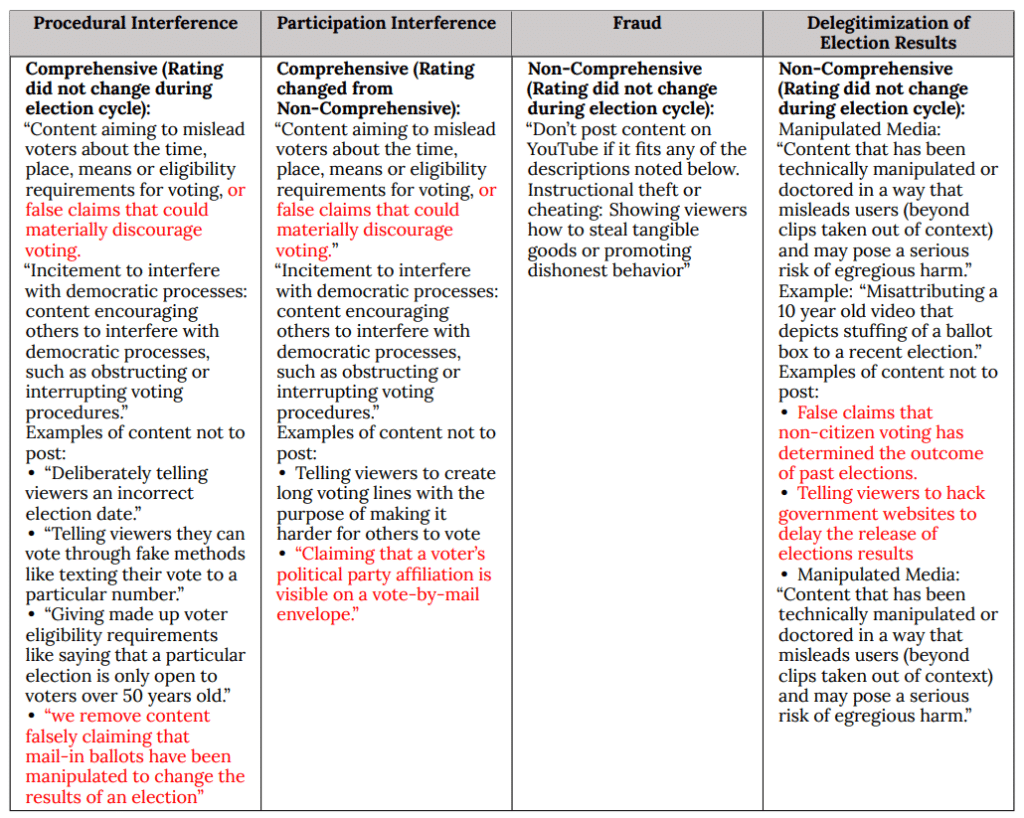YouTube CEO says Donald Trump suspension isn't permanent because of "grace period"
Justin Hendrix / Mar 5, 2021In remarks to the Atlantic Council, YouTube CEO Susan Wojcicki said her platform would eventually reinstate former President Donald Trump, who was suspended from the site after posting videos deemed to incite violence after the events of January 6th at the US Capitol. Despite posting multiple videos that violated YouTube policies, his account benefited from a "grace period", she said, and so it has not accumulated enough strikes against it to earn a permanent ban.
"I do want to confirm that we will lift the suspension of the channel, we will lift the suspension of the Donald Trump channel, when we determine that the risk of violence has decreased," said Wojcicki. "That’s per our policies. That’s how our three-strike system works. But when the channel is reinstated, it will be subject to the same policies that every other channel is – that follows. So if we see content that is uploaded that in any way violates any of our policies, incitement to violence or any kind of election-integrity policy violations, then a second strike would be issued. And when there are three strikes within a 90-day period, then the channel is removed."
When further questioned by Atlantic Council CEO Fred Kempe about when the former President's channel might be restored, Wojcicki said YouTube is considering "government statements, government warnings", reviewing "violent rhetoric that we're seeing on our platform," and relying on YouTube's "intelligence desk" to compile signals that would indicate the risk of violence has passed.
Wojcicki stated that the strike issued for the video inciting violence on January 6th was Trump's first. She went on to explain that was in part due to a technicality- while Trump had posted videos before January 6th that broke YouTube's rules, he was not penalized for them because YouTube extends a 'grace period' for violations after issuing a new policy, which it did less than a month before the events at the US Capitol.
"So one thing I want to point out is we did implement a policy and an enforcement starting when the states certified the election. So that was in December – 9th, I believe. So we actually at that point made it very clear that you couldn’t upload content that alleged that the outcome of the election was due to widespread fraud. Like, you could say, hey, I saw, you know, my neighbor committed fraud, but you couldn’t say the whole election was due to widespread fraud. And starting a month before the Capitol attack, we started removing content that alleged that the outcome was due to fraud. And, yes, there were a number of videos uploaded by the Donald Trump channel that were violations of that and that we did remove. So any new policy that we implement, we do have a grace period for giving strikes because we don’t want to just say overnight, hey, new policy, strike; like, you know, you lost your channel for seven-plus days. So we have a grace period where we remove the content but we don’t issue a strike. And so many videos were uploaded that were removed, but there wasn’t a strike. We are now giving strikes for that, of course, and we changed that in January."
A report by the Election Integrity Partnership found that YouTube was a key platform for sharing election-related disinformation. The platform "functioned both to provide official and familiar looking 'evidence' for misleading narratives and to consolidate otherwise disparate narratives as part of a broader picture," and noting that Trump's YouTube channel in particular put out videos that linked to six distinct incidents of election disinformation that "were viewed more than any other repeat spreader's videos." The Election Integrity Partnership report found YouTube's stated policies were the least comprehensive in relation to Twitter and Facebook, and assessed its policies around fraud and delegitimization of election results as "non-comprehensive."

YouTube "was kind of a place for misinformation to hide and be remobilized later,” said Kate Starbird, associate professor and co-founder of UW’s Center for an Informed Public, in a response to a question from journalist Casey Newton during a presentation by the Election Integrity Partnership. “From our view, it was a core piece of the repeat spreading phenomenon, and a huge piece of the cross-platform disinformation spread.”
Wojcicki's remarks came on a day when security was again heightened at the US Capitol and the House of Representatives suspended business due to a threat by a militia group, a threat Wojcicki acknowledged in her remarks.
"It's insane that Wojcicki would say this on a day where Congress was dealing with yet another heightened security alert," said Melissa Ryan, CEO of Card Strategies. "The House canceled their Thursday session over security concerns and YouTube is apparently talking about bringing Trump back on the same day, knowing his history of using social media to incite violence."
During the Atlantic Council appearance, Wojcicki also said she would be willing to testify to Congress. "Well, I can’t say it’s, like, something I’m dying to do right now. But I would always, of course– you know, if asked, I certainly would always be there and answer any question," she said. The statement is notable, as YouTube has actively tried to avoid scrutiny in the past.
"YouTube’s general public relations and governance policy over the years has been to be more opaque, keep its head down, keep quiet, and let the other platforms take the heat," wrote Evelyn Douek in Wired shortly after the 2020 election. "Wojcicki should be called to the Hill next time there is a hearing with tech CEOs. There is no question Jack Dorsey or Mark Zuckerberg should have to answer today that she shouldn’t."
Authors
